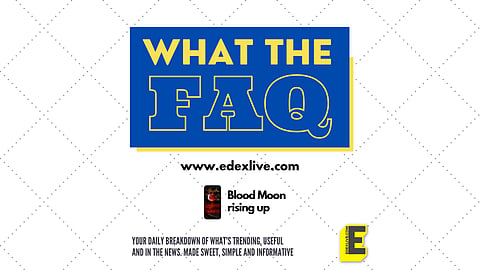

You’ve probably heard or read a lot about today’s lunar eclipse. The November 8 Moon will be visible as a big, red and completely eclipsed moon. Is it a rare phenomenon? Well, not very rare, but it does occur once in a few years. So, be sure to watch it today, if you can. It can be seen with the naked eye roughly between 5.30 to 6.20 pm in India. But now that there’s still time for occurrence, let us look at some exciting facts associated with the blood moon eclipse.
How does a blood moon occur?
It is a phenomenon which occurs during full moon eclipses only. Of course, the phrase “blood moon” is not given by any scientific community, but it is widely accepted and used. The word blood is associated with the Moon because during a full Moon eclipse, the Moon appears to be seeped in red colour. As the Sun, Moon and Earth are aligned for the eclipse, the Earth’s shadow falls on the moon and the sun’s rays, which contain a spectrum of seven colours, are scattered by the Earth’s atmosphere. Only the red light filters out and reaches the moon’s surface, resulting in a “blood moon rising”.
How often does it happen?
The term blood moon is actually associated with a phenomenon called the lunar tetrad. Since blood moons occur only during complete eclipses, these full moon eclipses take place four times in a span of two years (twice in a year, six months apart). This is known as a lunar tetrad. In 2022, a blood moon eclipse happened on May 15 and the next is today. Prior to 2022, blood moon eclipses had occurred in 2014-15 and the next is going to take place in 2032-33.
What are the different types of eclipses?
Apart from complete eclipses, there are two other kinds of eclipses, but they do not produce blood moons. In complete eclipses, better known as total eclipses, the Earth’s shadow completely envelops the moon. Then there exist partial eclipses in which the Earth’s shadow falls partially over the moon’s surface, making it appear to be “bitten” into. The size of the “bite” varies according to the position and alignment of the Sun, Moon and Earth. There are also penumbral lunar eclipses in which a shadow of the Earth’s outer surface falls on the Moon, making it appear darker in shade. These eclipses are easy to miss as the Moon is fully visible.
What’s with the Moon’s names?
Do you know that today’s moon is going to be a Beaver Moon? It is interesting to note that the full moon of every month has a name associated with it. Naming the full moon dates back to the ways of the native tribes of North America, who named the moon according to an event happening in that particular month. For example, January’s full moon is known as Wolf Moon because in the winters of January, wolves in American forests howled hungrily. Similarly, June’s full moon is called Strawberry Moon as strawberries are harvested in June. November was the time when the tribes set beaver traps to ensure the supply of fur during winters, so the full moon was called Beaver Moon.
Blood moon, understood. Now, what’s a blue moon?
Heard the phrase once in a blue moon? Well, some astronomical phenomenon is associated with this idiom. A blue moon is actually rare. It happens when two full moons occur in one month. The first moon is then named according to American tradition and the second moon is called blue moon. Although this moon does not really appear to be blue in colour, it does look bluish during certain atmospheric conditions. The last blue moon was seen in August 2021 and the next one is scheduled to take place in August 2023.
